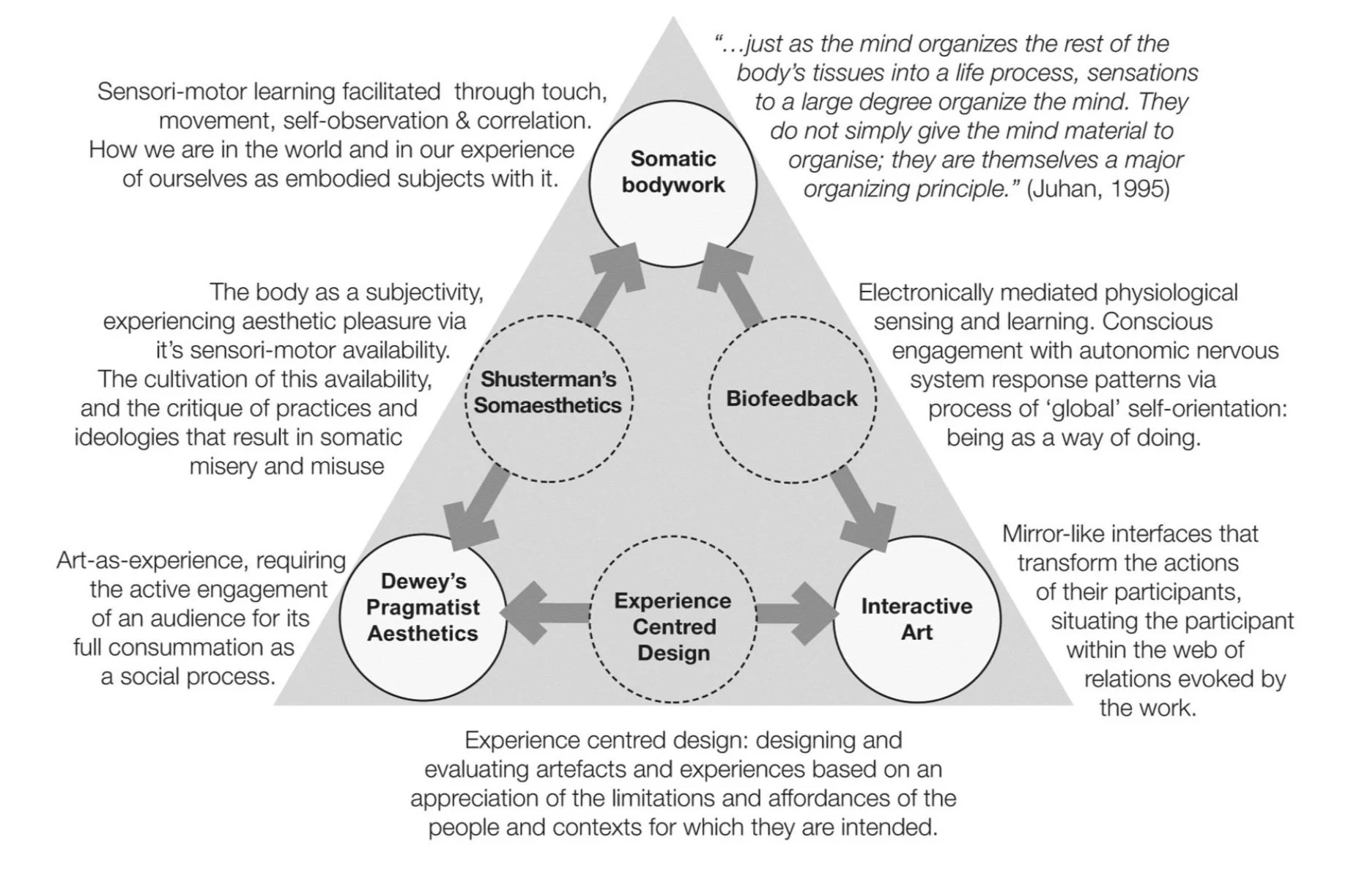Doctoral Research
2006 Doctoral Exegesis (Western Sydney University)
“Development and Evaluation of Participant-Centred Biofeedback Artworks” - practice-based research documenting and reflecting on a series of biofeedback artworks developed between 2004 and 2006 - and the evolution of a conceptual framework for working with biofeedback interaction as a form of participatory live-art, including analyses of audience experiences within these works, collected via retrospective reporting methods undertaken in collaboration with Dr Lizzie Muller.
BrightHearts Clinical Research
Ongoing clinical research led by Dr Angie Morrow, Staff Specialist - Brain Injury, at the Children’s Hospital at Westmead, Kids Rehab (New South Wales, Australia), researching the effectiveness of the BrightHearts biofeedback app. for reducing the pain and anxiery experienced by children undergoing painful procedures.
BrightHearts Published Research
Morrow, A.M., Burton K.L.O., Watanabe M.M., Cloyd B.H., Khut G.P., Developing BrightHearts: A Pediatric Biofeedback-Mediated Relaxation App to Manage Procedural Pain and Anxiety in Pain Practice, 2018 Jul;18(6):698-708. doi: 10.1111/papr.12655. Epub 2018 Jan 3.
Davies, C., , Skinner, R., Odgers, H., Khut, G., Morrow, A., 2018, The use of mobile and new media technologies in a health intervention about HPV and HPV vaccination in schools, Chapter in Book: Youth, Technology, Governance, Experience, 1st Edition, 2018, Routledge
Ostojic, K., Sharp, N., Paget, S., Khut, G., 2022, BrightHearts: A pilot study of biofeedback assisted relaxation training for the management of chronic pain in children with cerebral palsy – Paediatric and Neonatal Pain, 2022 – Wiley Online Library
Ostojic, K., , Paget, S., Webb, A., Khut, G.P., Morrow, A., Biofeedback assisted relaxation training and distraction therapy for pain in children undergoing botulinum neurotoxin A injections: A crossover randomized controlled trial in Developmental Medicine and Child Neurology, 05, June 2022 https://doi.org/10.1111/dmcn.15303
Cardiomorphologies
Cardiomorphologies is an interactive artwork that visualises and responds to changes in breath and heart rate. It was the main artwork developed during George Khut’s Doctoral Research at Western Sydney University, between 2004 and 2006, developed in collaboration with curatorial researcher Lizzie Muller (2005-2006); and software developers John Tonkin (2004) and Greg Turner (2005-2006).
Central to the research undertaken during the development and exhibition of this work, has been an investigation into the experience of people interacting within artwork. The research examines of the variety of experiences had during peoples interaction with the work - and ways this can help us understand ‘the work’ that the artwork is ‘doing’, and re-frame our concept of what this kind of creative practice is, and can be.
Cardiomorphologies Research Publications
Khut, G. (2007) Cardiomorphologies: An Inner Journey through Art In Norie NEUMARK, N & MIRANDA, M (eds.) IEEE MultiMedia, Vol. 14, No. 4, October – December, 2007, Washington, DC, IEEE Computer Society
Khut, G., 2006, Interactive Art as Embodied Enquiry: Working with audience experience, in EDMONDS, E., MULLER, L. & TURNBULL, D. (Eds.) Engage: Interaction, Arts & Audience Experience. University of Technology, Sydney, Creativity and Cognition Studios Press, Sydney, pp. 156-169
Khut, G., and Muller, L., 2005, Evolving Creative Practice: A reflection on working with audience experience in Cardiomorphologies. in Anastasiou, P., Smithies, R., Trist, K. & Jones, L. (Eds.) Vital Signs: Creative Practice & New Media Now. Australian Centre for the Moving Image, Melbourne, Australia, RMIT Publishing, pp. 21
Muller, L., Turner, G., Khut, G. and Edmonds, E. (2006) Creating Affective Visualisations for a Physiologically Interactive Artwork. IV06 (10th International Conference on Information Visualisation). London (UK), IEEE Computer Society, pp. 651-657
Thinking Through The Body
Thinking Through The Body was an interdisciplinary research project exploring the use and potential of movement, touch and proprioception in body-focussed interactive art and design.
For 14 days between July 2008 and July 2009, eight practitioners working across the disciplines of art, design and somatic bodywork came together over the course of three intense workshop-events to discuss and explore new approaches to ‘the body’ in contemporary art practice – with a special focus on the phenomenology of body-focused interactive experiences in art and somatic bodywork.
Developed in response to a call from the Australia Council for the Arts, Inter-Arts Office, for open-ended ‘blue sky’, interdisciplinary research and development projects (the Art Lab initiative), Thinkingh Through The Body aimed to create a laboratory for the creation of hybrid practice-based research work, combining approaches from interactive art, somatic bodywork and experiential aesthetics.
At the final ArtLab-funded workshop at Performance Space (Sydney, July 2009) the research team presented a collection of interactive art experiences (The Sensorium Gymnasium) – devised as ‘offerings’ to an invited audience. The prototype artworks and the collaborative processes used to devise them, have provided a foundation for continuing explorations.
Thinking Through The Body:
Published Research
Loke, L., Khut, G., Muller, L., Slattery, M., Truman, C. And Duckworth, J. Re-sensitising the body: Interactive art and the Feldenkrais Method in ENGLAND, D., and BRYAN-KINNS, N., (eds.) January 2013, International Journal of Arts and Technology, Special Issue on Whole-Body Interaction, 6 (4): p339 – 356
Loke, L. and Khut, G., 2011, Surging Verticality: An Experience of Balance, in Proceedings of the Fifth International Conference on Tangible, Embedded, And Embodied Interaction (TEI), Funchal, Portugal, January 22-26, 2011, ACM Press, New York, pp. 237-240

